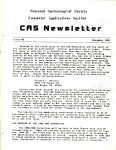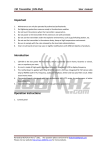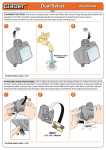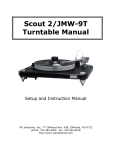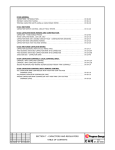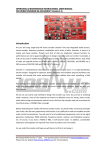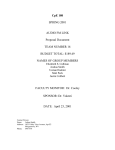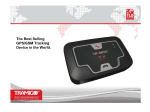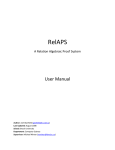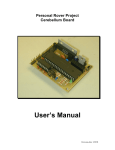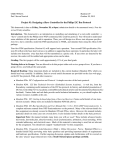Download FINAL PROPOSAL - Lane Department of Computer Science and
Transcript
West Virginia University College of Engineering Department of Computer Science and Electrical Engineering EE/CpE 180 Senior Design Spring 2001 @Home Radio FINAL PROPOSAL Team #17 Michael Guinn Christopher Johns Travis Masoner Perry Minigh Proposed Budget: $64.50 Faculty Monitor Dr. Wils Cooley Sponsor Dr. Mathew Valenti Date April 23, 2001 Contact Person: Michael Guinn 202 Wagner Road Morgantown, WV 26501 (304) 216-0721 [email protected] TABLE OF CONTENTS 1. 2. INTRODUCTION ............................................................................................................3 DESIGN OBJECTIVES...................................................................................................5 2.1 DESIGN GOALS AND CONSTRAINTS ....................................................................................5 2.2 DESIGN SPECIFICATIONS .....................................................................................................7 Performance.......................................................................................................................7 PC Interface.......................................................................................................................7 Signal Source .....................................................................................................................7 Software.............................................................................................................................8 Power ................................................................................................................................8 Size and Weight ..................................................................................................................8 2.3 DELIVERABLES ..................................................................................................................8 2.4 VALIDATION ......................................................................................................................9 3. SYSTEM DESCRIPTION..............................................................................................11 4. ORGANIZATION AND PLANNING............................................................................17 5. QUALIFICATIONS.......................................................................................................20 6. REFERENCES...............................................................................................................24 7. APPENDIX.....................................................................................................................25 2 1. INTRODUCTION The lifestyles of people frequently change due to technological advances targeted at making life better, easier, and more efficient. A large amount of new technology is directed towards the workplace, but people also create a demand for products that provide leisure and relaxation. The development of MP3 technology and the widespread use of the personal computer as a multimedia entertainment device has created the desire to conveniently capture the capability and versatility of the PC on existing audio equipment. The radio emerged as a form of family entertainment in the early 20 th century and remains a principal source of entertainment today. Many devices such as alarm clocks, automobiles, stereos, and CD players incorporate FM receivers. The simplicity and abundance of FM receivers makes it desirable to create new devices that exploit FM transmission technology so that it can be customized for individual use. Since the introduction of the MP3 audio format, many people have created immense libraries of music stored centrally on their PC hard drives. The sound quality of low-end speakers and the limited power output from a computer sound card, typical of most PCs in use today, leaves many users dissatisfied with their current setup. Present solutions currently exist, but not without limitations and other drawbacks. Connecting a PC to existing stereo equipment that has the desired performance qualities solves the problem, but has limitations. This approach requires arranging a room to accommodate both the stereo and PC equipment or 3 running wire between rooms to connect the devices. These limitations are inconvenient and limit the area where the music can be heard. Another solution requires the purchase of a high-end PC speaker and an amplification system. This method also limits the listening area, and requires investment in additional sound equipment. This system must be installed and setup, and leaves adequate existing equipment idle. By purchasing an audio transmission/reception product, the problem can be solved, but limitations remain. Here, because commercially available products operate at frequencies outside the standard FM bandwidth, a transmitter and receiver pair is required. This method remains deficient when it is desired to listen to music on more than one piece of audio equipment simultaneously. Multiple receivers would be required which increases the cost of the solution. Also, many types of audio equipment that have FM receivers built in, do not have auxiliary audio input jacks, which makes them incompatible with the receiver modules. All of the previously mentioned solutions require physical connection to both the sound source and the sound producing components. These connections produce limitations in the effectiveness of the system, and involve additional expenses or complicated setup. Users want to listen to their music in the locations they desire without the annoyance of connecting wires, and they want to be able to do this without replacing the equipment they already have. They need a means to accomplish these goals that provides versatility and remains cost effective. 4 2. DESIGN OBJECTIVES 2.1 Design Goals And Constraints The @Home Radio is a FM transmission system that will broadcast the desired input audio signal such that it can be tuned in with any existing standard FM receiver. It will operate in the frequency range of 88 to 108 MHz, and be powered by a 120V AC, 60Hz source or a 12V, DC source. This versatility permits operation from a wall outlet in the home as well as a cigarette lighter in an automobile. The @Home Radio will be capable of broadcasting a stereo FM signal, and will accept two audio inputs, a left and right channel. These inputs must be compatible with standard RCA jacks. The output frequency of the product may be controlled with or without the presence of a personal computer. When a PC is not present, the frequency will be able to be selected and modified with manual controls located on the product itself. The selected frequency will be displayed on the device, and there will be a control for switching between PC and manual control. When the @Home Radio is connected to a computer, the supplied software will control the frequency of operation. This software will run on a Windows platform, and have a graphical user interface. It will allow the selection of the transmission frequency, and display the frequency that was selected. The @Home Radio will be easy to use. Software installation will be straightforward and user friendly, with easily accessible help files to supplement 5 the functional program. Sufficient documentation describing how to use the product will be included and will be in the form of a user’s manual. Figure 1 illustrates how a user might implement the @Home Radio. Figure 1. User implementation of the @Home Radio The @Home Radio requires three essential items for correct operation: a power supply, signal source, and an FM receiver. To power the @Home Radio the user must connect it to a home wall outlet using the supplied AC adapter, or to a cigarette lighter with the supplied cigarette lighter adapter. Also, the desired audio source must be connected to the RCA jacks to supply the signal to be transmitted. Once the unit is powered, turned on, and the audio source is providing a signal, the user can tune in the transmitted signal on their FM receiver. For manual adjustment of the frequency the user may adjust the controls located on the device to change the frequency. When this occurs, the @Home Radio changes the transmission frequency, and the frequency display on the device is updated. The user will then need to retune the FM receiver such that it corresponds to the transmission frequency. 6 The @Home Radio also provides a means for PC controlled operation, and this requires some added setup. The user must install the software supplied with the @Home Radio, and the device must be connected to the computer with the included cable. The software will be straightforward and take very little time to learn. The user must run the @Home Radio program that was installed, and, provided that the previous steps for operating the @Home Radio have been completed, the user can change the transmission frequency via the mouse and/or keyboard. The @Home Radio will respond to the frequency change the same as it does when it comes from the manual controls. Also, the user will again need to retune the FM receiver to match the selected transmission frequency. 2.2 Design Specifications Performance ? Output a stereo FM signal ? See Appendix A for Audio Quality Specifications ? Output frequency ranging from 88–108 MHz with 200 kHz increments (See Appendix A) ? Output power of 100 mW (See Appendix A) PC Interface ? Standard 9-pin serial connector ? Serial port voltage levels of -3–25 V ? Serial port maximum current of 500 mA Signal Source ? Connects via standard RCA jacks 7 ? Max audio input level of –10 dBV (See Appendix A) ? Audio input frequency band of 20 Hz – 15 kHz (See Appendix A) Software ? Operates on a Windows operating system ? Employs a graphical user interface ? Will have Graphical User Interface ? Will be compatible with audio playback software such as Winamp or Real Player Power ? 120 V AC or 12 V DC Size and Weight ? Maximum dimensions of 10" x 6" x 4" ? Maximum weight of 2 lbs. 2.3 Deliverables ? @Home Radio unit ? 120 VAC to 12 VDC adapter ? Cigarette lighter adapter ? Serial cable ? Software CD ? User Manual ? Service Manual 8 2.4 Validation A testing environment will be set up upon completion of the device. A sequence of acceptance tests will be performed to validate its compliance with the initial requirements of the device. The following procedure must be followed to begin testing. ? Connect the device using the AC adapter to a wall outlet or the cigarette lighter adapter to a cigarette lighter. ? Connect the audio source to the RCA jacks on the device ? For PC control testing connect the PC to the device with the serial 9 pin serial cable, turn on the PC and load the @Home Radio software The system will be tested both with and without a PC connection. Table 1 details the tests to be performed and the acceptable results. 9 Table 1. Acceptance Testing Procedure and Expected Results Performance Test Transmission of audio signal Transmission of stereo signal Transmission frequency ranges from 88-108 MHz with 200 kHz increments 100 mW Output Power Produced Testing Method Transmission frequency is selected and tuned in on FM receiver Three separate tests will be conducted: one with signal sent to the left-channel only, one with signal sent to the right-channel only, and one with signal sent to both channels The transmission frequency is set to each value from 88108 kHz with 200 kHz increments and the FM receiver is tuned to the corresponding frequency Measure output voltage and current levels with multimeter Manual controls function The frequency is selected with manual control and the FM receiver is tuned to the new frequency PC controls function The frequency is selected with the PC program and the FM receiver is tuned to the selected frequency Acceptance Criteria The signal is received and heard The left and right signals can be heard in the corresponding left and right speakers of the receiving system The signal can be heard at each transmitted frequency when tuned to the same frequency Output Power = 100 mW The signal is heard on the FM receiver and the frequency display on the device is updated— If PC is connected the display is updated on the monitor The signal is heard on the FM receiver and the new frequency is displayed on both the PC and the device 10 3. SYSTEM DESCRIPTION The @Home Radio accepts the transmission frequency, power source, and audio signal as inputs. The display of the transmission frequency and the FM audio signal are outputs of the system. The block diagram shown in Figure 2 outlines these inputs and outputs as well as the internal components of the system. The PC control block represents the PC software’s ability to select the transmitted output frequency. The software interacts with the user of the system via the keyboard, mouse, and monitor, and it communicates with the PIC processor through a standard 9-pin serial cable using the RS-232 serial communication standard. The PC is not necessary for the system to operate, illustrated by the dotted line in Figure 2, but it provides convenient selection of the output frequency and allows the user to broadcast digital audio. When the device is connected to the PC, it will be able to accept frequency selection from both the PC and Up/Down frequency buttons. Two push button switches will provide manual control of the frequency selection. These switches are used to increase and decrease the output frequency in increments of 200 kHz. The PIC processor continuously polls these switches to determine if a change in output frequency is necessary. The PIC processor interprets the values from the manual and PC controls and determines the selected frequency. This frequency is output to the display driver that controls the 7-segment display, and, if a PC is connected, it is serially transmitted to the PC for the software to display. 11 The tasks of generating the carrier frequency, preventing frequency drift and modulating the left and right audio signals onto the carrier frequency are carried out by a single integrated circuit. This IC has a built-in phase-lock loop that generates and stabilizes the carrier frequency. This built-in stereo modulator combines the left and right signals with the carrier frequency and performs some amplification on the signal before being output. The signal output by the IC requires more amplification before transmission. This RF amplifier operates on the output from the stereo modulator and provides the remaining amplification needed to source 100 mW of output power. The data flow diagram in Figure 3 shows the top level of the tasks performed by all system software. This software runs on the PIC processor and communicates with the PC software when a PC is present. Figures 4 and 5 separate the tasks into two areas – those to be completed by the PC (Figure 4), and those to be completed by the PIC Processor (Figure 5). Arrows that connect the two diagrams show where data is shared between the PC and PIC via a serial cable. 12 Block Diagram FM Transmitter 7-Segment Display/ PC Monitor Audio Signal Display Information Output Frequency @Home Radio Software Commands and Data Frequency Selection PC Keyboard / Mouse Up/Down Push Buttons Figure 3. Context Level 0 DFD for @Home Radio Configuration Data Current Output Frequency Data FM Transmitter Previous Output Frequency Data Audio Signal Current PC Output Frequency Data Send Audio Signal Audio Signal Information Get User’s Frequency (Interactive PC Program) Commands and Data Display Information PC Keyboard PC Monitor A B Figure 4. Context Level 1 DFD for @Home Radio (Top) 15 A B Current PC Output Frequency Data Current Output Frequency Data PIC Frequency Configuration Data Storage FM Transmitter Output Frequency Determine Correct Frequency (PC or Board DIP) and Send to Transmitter Frequency Selection Current Output Frequency Data Current Output Frequency Data Up/Down Push Buttons Board 7-Segment Display Figure 5. Context Level 1 DFD for @Home Radio (Bottom) 16 4. ORGANIZATION AND PLANNING Table 2, shown on the following page, is a Gantt Chart that displays a proposed schedule for design implementation. To be completed in the Fall 2001 semester, this chart shows which tasks are to be completed, the week-byweek schedule for completion of each task, and the group members responsible for completing each task. A bold number in the personal effort column indicates the group member who is ultimately responsible for each task. 17 BUDGET Table 3. Proposed Budget 1. PIC Processor 2. RS-232 Converter 3. Stereo Modulator 4. RCA Jacks 5. Power Adapter 6. Antenna 7. RF Amplification Components 8. Frequency Display 9. Packaging 10. Oscillators 11. Miscellaneous Items Total Cost $11.00 $4.00 $5.00 $1.50 $8.00 $8.00 $10.00 $4.00 $5.00 $6.00 $2.00 $64.50 Total Requested from CSEE Senior Project Account: $64.50 _________________________________________ Project Sponsor Signature Date _________________________________________ Project Monitor Signature Date 18 Table 4. Budget Justification 1. PIC Processor PIC16F877 Newark #12C1952 2. RS-232 Converter MAX-232: 5V, Multi-Channel RS-232 TX/ RX Digikey #MAX232CPE-ND 3. Stereo Modulator BH1415 Rohm #BH1415 4. RCA Jacks 2 RCA style jacks @ $0.65 each Jameco #112475 5. Power Adapter 120 VAC to 12 VDC Jameco #104578 6. Antenna 1/4 wave whip antenna and connector Digikey #ANT-315-PW-LP-ND and #CONREVSMA002-ND 7. RF Amplification Components 1/4 W resistors, capacitors, transistors 8. Frequency Display 4 7-segment displays @ $1.00 each Jameco Electronics #161517 9. Packaging 1/8" Plexiglass sheet Lowes 10. Oscillators 2 Crystal Oscillators Digikey 11. Miscellaneous Solder, Glue Lowe's 19 5. QUALIFICATIONS Resumes for the designers of the @Home Radio System – the FM Audio Link Gold Team – are provided on the following four pages. 20 202 Wagner Road Morgantown WV 26501 Phone (304) 216-0721 E-mail [email protected] Michael R. Guinn Objective Employment To further my knowledge and experience in the areas of computers and electronics through coursework and job-related experience. May 2000 – Present West Virginia University Morgantown, WV Networking Assistant for College of Engineering ? Maintained phone and network connectivity ? Installed numerous fiber optic and CAT-5 cables in a network upgrade ? Assisted in SRX phone system installation July 1995 – May 2000 McDonald’s of Weston Crew Trainer Weston, WV ? Trained new crew members in customer service and cooking procedures ? Operated cash registers and food preparation equipment ? Cleaned equipment, transferred products to neighboring stores Education 1997 – Present West Virginia University Morgantown, WV BS Computer Engineering, BS Electrical Engineering ? ? ? ? Expected Date of Graduation: December 2001 GPA: 3.36 / 4.00 Presidential Scholarship, National Merit Scholarship Dean’s List 3 Semesters Qualifications Operating Systems: ? MS Windows 3.1, 95, 98, ME, NT, 2000; Unix; OS/2 Programming Languages: ? Ada, ANSI C, Assembly, Basic, HTML Networking: ? 4-pair and 25-pair cable termination; Single, 6, and 24 jack panel wiring; Fiber optic wire termination; Cisco switch web browser-based operation Software: ? MS Word, Excel, PowerPoint; MATLAB; Various Browsers & Mail Programs References Provided upon request. 21 PO Box 528 Jane Lew, WV 26378 Phone (304) 884-7738 E-mail: [email protected] Perry L. Minigh Objective A computer or electrical engineering position where my education and skills will be fully utilized and my potential enhanced while enabling me to make a contribution. Education August 1997 – Present West Virginia University Expected Degrees in December 2001 ? Bachelor of Science in Computer Engineering. ? Bachelor of Science in Electrical Engineering. Morgantown, WV Area of Emphasis ? Communications and Signal Processing. Cumulative GPA as of May 2000 ? 3.208 / 4.000 Technical Skills Working knowledge with C, Ada, Assembly Language, Unix, HTML, Matlab including signal processing toolboxes, Pspice circuit simulation software, Windows 95/98/NT, Microsoft Word, Excel, PowerPoint, and Publisher. Work Experience J.W. Ebert Corporation (McDonald’s) Crew Trainer April 1996 – Present Weston, WV ? Pays approximately 30% of Cost of Education. ? Responsible for training new employees job tasks and proper procedures. ? Responsible for maintaining proper food production levels. ? Responsible for maintaining / cleaning of equipment. ? Cashier/Customer Service, created a friendly environment in all situations. West Virginia Department of Highways Summer Employee Weston, WV Summers 1998, 1999, & 2000 ? Leadership role over other summer employees. ? Given various individual tasks and was responsible for their completion. ? Various road construction activities such as hand patching paved roads, replacing/installing minor drainage structures. ? Provided support to the public during various duties such as flood clean up. Professional Memberships Student Member of IEEE, IEEE Computer Society, IEEE Industrial Electronics Society. References Provided upon Request 22 Travis Masoner Rt. 1 Box 112M Jane Lew, WV 26378 Home (304) 884-7525 School (304) 598-3186 [email protected] Objective To gain experience in the field of Computer and Electrical Engineering, for further employment upon graduation. Experience 1995–Present Well Tender Petroleum Resources Inc. Roanoke, WV ? Maintain wells by weekly checks and repairs. ? Calculate average production weekly and monthly. Summers 1998–1999 Labor Worker Petroleum Resources Inc. Roanoke, WV ? Painted and repaired wells that were in need. ? Constructed new office which included masonry, wiring, and carpentry. Summers 1997–1998 Labor Worker Kimberly Industries Inc. Charleston, WV ? Worked with dirt compaction material and drainage materials. ? Operated miscellaneous equipment and also worked as a flagman. Summers 2000 Intern Information Research Corp. Fairmont, WV ? Worked with software and system engineering resources ? Projects dealing with oracle and web base systems ? Created and maintained web pages. Education 1997–present West Virginia University Morgantown, WV BS in Computer and Electrical Engineering (expected, Dec.2001) Departmental GPA: 3.1 Comment: ? IEEE member (Industrial Electronics and Computer Societies) ? Member of the Formula Lightning Team (electric racing project) 1996-1997 West Virginia Wesleyan College High School Partnership in Education ? Completed two years of calculus Buchannon, WV Community Activities Member of the Boy Scouts of America as an Assistant Scoutmaster (obtained the Eagle Scout Award as a youth). References Available upon request 23 6. REFERENCES ? Web Page: “Digi-Key Corporation” http://www.digikey.com/ ? Web Page: “Jameco Electronics” http://www.jameco.com/ ? Web Page: “Newark Electronics” http://www.newark.com/ ? Web Page: “Microchip Technology” http://www.microchip.com/ ? Web Page: “ROHM Company, Ltd.” http://www.rohm.com/ 24 7. APPENDIX This appendix contains excerpts from data sheets for the BH1415F and MAX232 chips intended for use with the proposed @Home Radio system. 25

























